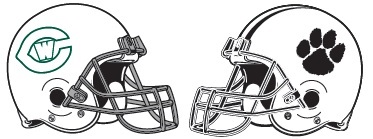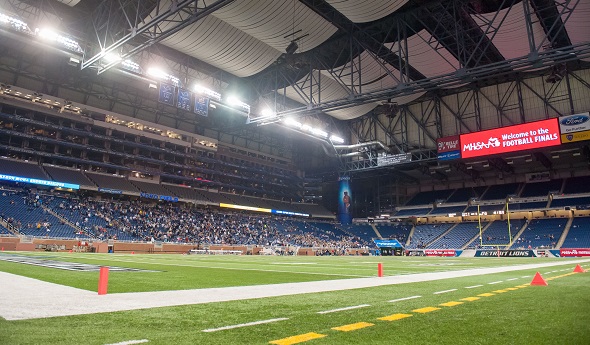
A Game for Every Fan: 11-Player Finals
November 24, 2015
By Geoff Kimmerly
Second Half editor
You’ll recognize many of the teams playing for MHSAA 11-player football championships this weekend at Ford Field.
Of 16 finalists, 11 are previous champions. Seven of the 11 have won at least three titles.
 Then there’s Romeo, Chelsea, River Rouge, Clinton and Pewamo-Westphalia. All are seeking their first MHSAA championship in the sport – with Romeo, Chelsea and River Rouge getting the opportunity to play for one for the first time.
Then there’s Romeo, Chelsea, River Rouge, Clinton and Pewamo-Westphalia. All are seeking their first MHSAA championship in the sport – with Romeo, Chelsea and River Rouge getting the opportunity to play for one for the first time.
See below for a look at all of the finalists who will take the field this weekend. The Division 8, 2, 6 and 4 games are Friday, with the odd-numbered divisions playing Saturday. Tickets cost $10 and are good for all four games on one day. Click for a full schedule.
The first three Friday games will be broadcast live on Fox Sports Detroit’s primary channel (check cable/satellite box listings for your specific channel) with the Division 4 game tape delayed at 11:30 p.m. on FSD but available live on FoxSportsDetroit.com. Saturday's games all will air live on Fox Sports Detroit. Audio broadcasts will be available on the MHSAA Network website.
Rankings below were voted upon by The Associated Press’ media panel but can be used only as a guide; the AP establishes divisions before the season for poll purposes, but many teams ended up in different divisions at playoff selection. Statistics are current unless noted.
 Division 1
Division 1
ROMEO
Record/rank: 12-1, No. 7
Co-coaches: Curt Rienas and Jason Couch, 13th seasons (90-43)
League finish: First in Macomb Area Conference White.
Finals history: Has never played in an MHSAA Final.
Best wins: 26-14 over No. 9 Macomb Dakota, 28-14 over No. 10 Clarkston in Pre-District, 34-14 over No. 8 Lapeer in District Final, 40-29 over No. 6 Detroit Catholic Central in Regional Final, 48-21 over No. 5 Grand Ledge in Semifinal.
Players to watch: QB Paul Hurley, 6-2/190, sr. (1,451 yards/23 TDs passing, 332 yards/3 TDs rushing); SE/DB Brad Tanner, 6-2/180, sr. (701 yards/13 TDs rushing, 564 yards/8 TDs receiving); TE/LB Mitchell Heimbuch, 6-3/220, sr. (676 yards/9 TDs receiving, 53 tackles/4 sacks/4 interceptions); DB Kade Messner, 5-10/175, jr. (62 tackles/2 interceptions).
Outlook: Romeo has advanced to its first MHSAA Final despite facing eight playoff teams and defeating seven – the lone loss was by three to Utica Eisenhower in the regular-season finale. No one’s individual numbers pop out, but as a team the Bulldogs run for 6.2 yards per carry and average nearly 12 per pass while giving up only 9.9 points per game. Heimbuch has reportedly committed to sign with Western Michigan University and is a force on both sides of the ball.
DETROIT CASS TECH
Record/rank: 11-2, No. 4
Coach: Thomas Wilcher, 18th season (141-59)
League finish: Second in Detroit Public School League East I.
Finals history: Division 1 champion 2012 and 2011.
Best wins: 16-10 over No. 9 Macomb Dakota in Regional Final, 48-41 over Canton in Semifinal, 33-8 over Division 2 No. 6 Detroit East English, 27-0 over Southfield.
Players to watch: QB Rodney Hall, 6-3/215, jr. (2,232 yards/20 TDs passing, 1,053 yards/14 TDs rushing); TE/LB Timothy Walton, 6-2/225, sr. (108 tackles through 11 games); WR/DB Demetric Vance, 6-2/200, sr. (55 tackles/4 interceptions through 11 games); WR Donovan Peoples-Jones, 6-1/195, jr (1,141 yards/17 TDs receiving); RB/SS Jaylen Kelly-Powell, 6-0/190, jr. (53 tackles/2 interceptions through 11 games); OL/DT Michael Onwenu, 6-3/360, sr.
Outlook: Cass Tech is loaded with talent – leading a large group of college-bound players are Onwenu (Michigan), Vance (Michigan State) and Walton (Illinois), and Peoples-Jones and Kelly-Powell will have their picks as well. The Technicians' only losses were to Division 2 finalist Detroit King, twice. But all eyes will be watching to see if Hall trots onto the field – he missed the Semifinal win with an injury that reportedly was season-ending. Sophomore Aaron Jackson stepped in and accounted for three touchdowns.
 Division 2
Division 2
LOWELL
Record/rank: 12-1, No. 4 in Division 3 (regular season)
Coach: Noel Dean, 20th season (201-35)
League finish: First in Ottawa-Kent Conference White
Finals history: Three MHSAA titles (most recent 2009), two runner-up finishes.
Best wins: 49-34 over No. 2 Walled Lake Western in Semifinal, 36-7 over Division 3 (regular season) No. 5 Muskegon in Regional Final, 35-13 over East Grand Rapids, 28-14 over Grand Rapids Christian.
Players to watch: QB Ryan Stevens, 6-2/160, sr. (2,418 yards/31 TDs passing, 945 yards/16 TDs rushing); RB/LB Max Dean, 5-11/185, sr. (1,164 yards/17 TDs, 57 tackles/7.5 sacks); WR/DB Gabe Steed, 6-1/160, sr. (1,058 yards/17 TDs receiving); LB/RB Nathan Stephens, 5-10/185, jr. (55 tackles); TE/LB Alex Anschutz, 6-1/185, sr. (518 yards/10 TDs receiving, 39 tackles/5 interceptions).
Outlook: The Red Arrows are playing for a championship for the first time since finishing runner-up in 2011 and lost only to Walled Lake Western in the season opener – avenging that loss in the Semifinal. The skill positions are dominated by seniors who also helped the team advance to the Regional Final last season and navigate one of the most competitive leagues in the state again this fall – among those opponents, East Grand Rapids, although unranked, made the Semifinals in Division 3.
DETROIT MARTIN LUTHER KING
Record/rank: 13-0, No. 1
Coach: Dale Harvel, seventh season (60-19)
League finish: First in Detroit Public School League East I
Finals history: Division 2 champion 2007, two runner-up finishes.
Best wins: 42-6 over honorable mention Wyandotte Roosevelt in District Final, 12-10 over No. 9 Warren DeLaSalle, 20-15 and 26-12 (Regional Final) over No. 6 Detroit East English, 31-28 and 27-25 over Division 1 No. 4 Detroit Cass Tech.
Players to watch: QB/LB Armani Posey, 6-1/200, sr. (1,829 yards/19 TDs passing); WR/DB Donnie Corley, 6-3/185, sr. (1,221 yards/14 TDs receiving); WR/DB Dontre Boyd, 5-10/160, sr. (563 yards, 5 TDs receiving); RB Martell Pettaway, 5-10/210, sr. (1,514 yards/22 TDs rushing); WR/DB Lavert Hill, 5-10/175, sr. (11 interceptions through regular season);
Outlook: From the season opener against reigning champion Warren DeLaSalle through last week’s Semifinal against Livonia Franklin, King has been arguably the most impressive team in the state regardless of division. The Crusaders have won big and close – four victories came by a touchdown or less. Hill has at least 13 interceptions and has scored on offense, defense and special teams, and Corley had nine interceptions through the end of the regular season. He’s one of the state’s most pursued college prospects; Pettaway has committed to West Virginia and Hills has committed to Penn State, among others who will play at the next level.
 Division 3
Division 3
CHELSEA
Record/rank: 12-1, No. 9
Coach: Brad Bush, 19th season (149-56)
League finish: Tied for first in Southeastern Conference White.
Finals history: Has never played in an MHSAA Final.
Best wins: 35-7 over No. 3 Coldwater in Semifinal, 29-16 over honorable mention Trenton in District Final, 35-12 over No. 10 Allen Park in Regional Final, 9-7 over Ann Arbor Pioneer.
Players to watch: QB Jack Bush, 6-2/175, jr. (1,797 yards/17 TDs passing, 9 TDs rushing); WR Bailey Edwards, 6-3/180, sr. (727 yards/8 TDs receiving); TB Trey Seitz, 6-1/185, sr. (875 yards/9 TDs rushing); OT Jay Packard, 6-3/275, sr.; LB Ryan Stasiak, 6-1/180, sr.
Outlook: Chelsea will play in its first championship game but has long been a contender; this was the 16th season in 17 that the Bulldogs made the playoffs, and they had won at least 10 game five other times over the last 16 seasons before setting a program record for victories this fall. The lone loss, to Ypsilanti Community, cost them the outright league title, but the 34 points given up that game were a season high for a defense allowing only 9.2 per game and held Coldwater’s celebrated running attack to only 119 yards on 37 carries in the Semifinal.
ORCHARD LAKE ST. MARY’S
Record/rank: 11-1, No. 2
Coach: George Porritt, 27th season (245-67)
League finish: First in Detroit Catholic League Central.
Finals history: Six MHSAA titles (most recent 2014), six runner-up finishes.
Best wins: 14-7 over East Grand Rapids in Semifinal, 38-0 over Division 2 No. 9 Warren DeLaSalle, 14-7 over Division 1 No. 6 Detroit Catholic Central, 24-12 over Division 7 No. 6 Detroit Loyola.
Players to watch: RB/SS Justin Myrick, 5-10/190, sr. (1,049 yards/13 TDs rushing); RB/DB Ryan Johnson, 5-8/175, jr. (651 yards/11 TDs rushing); QB Brendan Tabone, 6-1/180, sr. (1,036 yards/5 TDs); OL/DL Cameron Kolwich, 6-5/270, sr. LB Josh Ross, 6-1/225, jr.
Outlook: St. Mary’s has rumbled into its fifth final in six years with seven straight wins including the avenging of its lone loss, to Warren DeLaSalle in Week 5. The Eaglets ride a strong running game, although one of three backs may need to take the lead Saturday – Johnson was the leading rusher in the Semifinal with Myrick out with an injury and senior Brandon Adams then also getting hurt during the game. Ross keys a defense that hasn’t given up more than 14 points in a game since the loss, and receiver Kaylee Hamler (569 yards/3 TDs receiving) is another standout junior.
 Division 4
Division 4
FLINT POWERS CATHOLIC
Record/rank: 11-2, unranked
Coach: Bob Buckel, fifth season (45-15)
League finish: Second in Saginaw Valley League Blue.
Finals history: Two MHSAA titles (most recent 2011).
Best wins: 41-0 over No. 10 Goodrich in Pre-District, 28-7 over Division 5 (regular season) No. 8 Richmond in the Regional Final, 21-14 over No. 1 Detroit Country Day in the Semifinal.
Players to watch: QB Noah Sargent, 5-11/175 sr. (1,561 yards/18 TDs passing; 1,020 yards/15 TDs); LB Spencer Gomez, 5-10/195, jr. (69 tackles through 12 games); HB Reese Morgan, 5-10/185, sr. (981 yards/10 TDs rushing); NG Daurel Tolbert, 5-9/252, sr. (72 tackles/3 sacks through 12 games).
Outlook: Powers might not have been regarded as a title contender heading into the playoffs, and again while down two touchdowns in last week’s Semifinal win over Country Day. But the Chargers’ only losses were on opening night to Flushing and then to eventual Division 2 District champ Midland Dow in Week 5, and they’re lead by a championship-winning coach in Buckel, who has 211 wins over 33 seasons at four schools. Powers gave up only 60 points total in its 11 wins this fall.
ZEELAND WEST
Record/rank: 13-0, No. 1 in Division 3 (regular season)
Coach: John Shillito, 11th season (110-22)
League finish: First in O-K Green.
Finals history: Three MHSAA titles (most recent 2013).
Best wins: 38-28 over No. 4 Comstock Park, 28-21 over honorable mention Hudsonville Unity Christian in the Regional Final, 46-8 over Ada Forest Hills Eastern in the Semifinal, 42-34 over Oak Park.
Players to watch: QB/DB Casey Brinks, 6-0/170, sr. (456 yards/4 TDs rushing, 576 yards/7 TDs passing); FB/DB Darius Perisee, 5-9/155, sr. (1,906 yards/29 TDs rushing); HB/LB Tyler Thompson, 6-1/200, sr. (925 yards/19 TDs rushing); HB/DB Dakota Geurink, 6-0/185, sr. (685 yards/8 TDs rushing).
Outlook: After losing to Muskegon in the Semifinal a year ago, West is back to try for its third title – and second perfect season – over the last half decade. The Dux have piled up 5,000 yards rushing with their Wing-T rushing attack, with fullback Perisee getting nearly 40 percent of those yards behind a line averaging 6-foot-1 and 247 pounds. The defense has progressively improved throughout the season and has given up more than one touchdown only once over the last seven games. Shillito is up to 266 wins over 32 seasons and four schools.
Division 5
GRAND RAPIDS WEST CATHOLIC
Record/rank: 11-2, No. 6
Coach: Dan Rohn, ninth season (98-19)
League finish: First in O-K Blue.
Finals history: Three MHSAA titles (most recent 2014), two runner-up finishes.
Best wins: 24-14 over No. 1 Menominee in Regional Final, 42-13 over No. 4 Lansing Catholic in Semifinal, 21-14 over No. 9 Reed City in District Final, 28-14 over honorable mention Muskegon Oakridge in Pre-District, 45-28 over Division 4 honorable mention Hudsonville Unity Christian, 42-35 over Division 4 No. 4 Comstock Park.
Players to watch: QB Gaetano Vallone, 5-10/160, soph. (2,474 yards/28 TDs passing, 814 yards/12 TDs rushing); RB/LB Denny Alt, 5-10/175, sr. (1,364 yards/17 TDs rushing); OL/DL Carl Myers, 6-3/260, sr.; WR/DB Conner Nemmers, 6-1/193, sr. (928 yards/13 TDs receiving).
Outlook: No one can argue West Catholic doesn’t deserve a return to Ford Field after the Falcons downed three top-10 teams and an honorable mention to get to this weekend. This is West Catholic’s fifth straight appearance in a championship game – it is 2-2 with two straight wins over the last four trips. Vallone has continued to impress during his first season as the starter at quarterback, but the Falcons can attack a number of ways with Alt carrying the load and Nemmers a tough matchup on the receiving end of Vallone’s passes.
RIVER ROUGE
Record/rank: 12-1, honorable mention
Coach: Corey Parker, seventh season (55-20)
League finish: First in Michigan Metro Athletic Conference Blue.
Finals history: Has never played in an MHSAA Final.
Best wins: 51-25 over honorable mention Algonac in the Regional Final, 28-26 over No. 5 Ida in the Semifinal, 41-12 over Romulus, 40-34 over Riverview.
Players to watch: QB Antoine Burgess, 5-10/180, sr. (1,484 yards/27 TDs passing, 1,040 yards/11 TDs rushing {rushing total does not include last week}); WR Aaron Vinson, 6-2/190, sr. (513 yards/11 TDs receiving); Alexander Carter, 5-10/205, soph. (1,076 yards/10 TDs through 12 games); OL Julius Laidler, 6-4/300, sr.
Outlook: River Rouge is no longer just a basketball school. The Panthers have been known statewide for hoops success from a half century ago, but they’ve won 10 or more football games three of the last four seasons and made the playoffs six straight, with this their first championship game appearance. River Rouge has its share of playmakers, but perhaps most notable and almost most noticeable are the guys in front of them. The Panthers’ offensive linemen average 6-1, 312 pounds.
 Division 6
Division 6
CLINTON
Record/rank: 13-0, Division 7 (regular season) No. 5
Coach: Scott McNitt, 31st season (195-109-1)
League finish: First in Tri-County Conference.
Finals history: Division 6 runner-up 2013.
Best wins: 14-10 over No. 4 Monroe St. Mary Catholic Central in Pre-District, 43-20 over No. 9 Madison Heights Madison in District Final, 49-20 over honorable mention Jackson Lumen Christi in Regional Final, 42-20 over Division 7 (regular season) No. 8 Grand Rapids NorthPointe Christian in Semifinal, 36-18 over Division 8 honorable mention Ottawa Lake Whiteford.
Players to watch: RB/LB Mathew Sexton, 5-11/170, sr. (2,247 yards/34 TDs rushing, 212 yards/4 TDs receiving, 99 tackles); QB Kaden Kelly, 6-3/160, sr. (680 yards/8 TDs passing); RB/LB Noah Poor, 5-9/180, sr. (1,029 yards/15 TDs rushing); OL/LB Ken DeShano, 6-0/200, sr. (101 tackles/6 sacks); TE/LB Blake Rogers, 6-0/175, sr. (79 tackles).
Outlook: Clinton’s run to its second championship game appearance rivaled Romeo’s in Division 1; the Redskins defeated the reigning champion in addition to multiple ranked and/or undefeated powers after emerging from a league that put four teams in the postseason. Sexton was the team’s second-leading rusher and tackler in the Final as a sophomore and is the player who receives the most attention, but as a team Clinton has run for 3,979 yards and 59 touchdowns with Kelly making key passes as opportunities have arisen.
ITHACA
Record/rank: 13-0, No. 1
Coach: Terry Hessbrook, 12th season (127-18)
League finish: First in Tri-Valley Conference West.
Finals history: Four MHSAA titles (most recent 2013), one runner-up finish.
Best wins: 56-14 over honorable mention Vassar in Pre-District, 42-6 over No. 6 Sanford Meridian in District Final, 28-19 over Division 7 (regular season) No. 1 Traverse City St. Francis in Semifinal, 38-0 over Division 7 No. 9 Saginaw Michigan Lutheran Seminary.
Players to watch: OL/LB Jace Demenov, 6-0/205, sr. (153 tackles); QB/DB Jake Smith, 6-1/170, sr. (1,342 yards/24 TDs passing, 1,632 yards/31 TDs rushing); WR/DB Grant Gimmey, WR/DB, sr. (284 yards/6 TDs receiving); WR/DB Spence DeMull, 6-4/175, sr. (364 yards/8 TDs receiving); RB/NG Jonah Loomis, 5-10/180, sr. (850 yards/15 TDs rushing, 84 tackles).
Outlook: A group of 17 seniors have unfinished business at Ford Field after last season’s defeat in the Final by Monroe St. Mary. Smith has been the key player over the last two seasons and took his game to another level this fall. But just as important Saturday could be Demenov, who is charged with leading a defense that must shut down Clinton’s dominating rush attack. DeMull was injured at the start of this season, but has steadily returned to his elite status and could be a tough matchup this weekend.
 Division 7
Division 7
PEWAMO-WESTPHALIA
Record/rank: 13-0, No. 4
Coach: Jeremy Miller, third season (33-5)
League finish: First in Central Michigan Athletic Conference.
Finals history: Division 7 runner-up 2011.
Best wins: 30-0 over Detroit Loyola in Semifinal, 38-28 over No. 7 Saugatuck in District Final, 26-25 over Division 6 No. 9 Madison Heights Madison, 34-7 over Division 8 No. 9 Fowler.
Players to watch: RB/DE Jared Smith, 6-0/205, jr. (3,096 yards/52 TDs rushing); QB Jimmy Lehman, 6-3/200, soph. (654 yards/8 TDs passing through 12 games); FB/LB Nate Jandernoa, 5-11/220, sr. (348 yards/3 TDs rushing through 12 games); OL/LD Matt Fox, 6-1/295, sr.
Outlook: Pewamo-Westphalia is making its second trip to Ford Field in five seasons but this time on the legs of a record-break running back. Smith eclipsed the MHSAA single-season rushing touchdown record two weeks ago and the single-season yardage record last week, and has more than 5,000 yards combined over the last two seasons. Fox leads a line that averages 6-2, 259 pounds, and Jandernoa keys a defense that has given up three points total over the last two weeks and only 9.1 per game despite a schedule with seven playoff opponents.
ISHPEMING
Record/rank: 12-0, No. 2
Coach: Jeff Olson, 24th season (182-79)
League finish: First in Mid-Peninsula Conference.
Finals history: Four MHSAA titles (most recent 2013), two runner-up finishes.
Best wins: 22-14 over No. 3 New Lothrop in Semifinal, 20-14 over Division 8 No. 2 St. Ignace, 22-16 over Negaunee, 32-8 over Calumet.
Players to watch: QB/DB Ozzy Corp, 6-5/205, sr. (644 yards/7 TDs rushing, 1,047 yards/7 TDs passing through eight games); RB/LB Isaac Olson, 5-10/175, jr. (662 yards/7 TDs rushing through eight games); TE/DE Thomas Finegan, 5-11/200, sr. (453 yards/3 TDs receiving, 7 interceptions through eight games); FB/LB Halen Carello, 5-8/180, sr.
Outlook: The Hematites are seeking their third MHSAA title in four seasons. Corp led a new group of contributors to Ford Field last season and they came up short against Detroit Loyola, but a number of those players returned to win nine games against playoff teams this fall including a pair each against rivals Ishpeming Westwood and Iron Mountain. Ishpeming played only eight regular-season games because it didn’t have an opponent Week 6, but total has given up 99 points – 8.3 per game – with five players back who had tackles in last season’s Final.
 Division 8
Division 8
WATERFORD OUR LADY
Record/rank: 13-0, No. 3
Coach: Josh Sawicki, third season (30-5)
League finish: First in Detroit Catholic League CD.
Finals history: Division 8 champion 2002, two runner-up finishes.
Best wins: 36-20 over honorable mention Ottawa Lake Whiteford in Semifinal, 32-6 over Division 7 (regular season) No. 9 Saginaw Michigan Lutheran Seminary in Regional Final, 36-10 over Division 4 No. 9 Bloomfield Hills Cranbrook Kingswood.
Players to watch: QB Clay Senerius, 6-3/175, sr. (2,913 yards/34 TDs passing); WR/DB Devin Senerius, 6-2/170, sr. (1,288 yards/12 TDs receiving, 39 tackles/4 interceptions); RB/DB Chris Cartier, 6-3/180, sr. (1,264 yards/20 TDs rushing, 395 yards/7 TDs receiving, 66 tackles/4 interceptions); LB/WR Ryan Kostich, 6-1/210, sr. (352 yards/11 TDs rushing, 590 yards/9 TDs receiving, 158 tackles/6 sacks).
Outlook: Our Lady has set a program record for victories on the way back to the Finals for the first time since 2002, with Whiteford last week the first team to come within 25 points. The Lakers are led by their highest-scoring offense ever, with Senerius to Senerius a dangerous passing comboand Cartier and Kostich providing balance on the ground and as additional targets. Kostich, senior Gabe Nickels (147 tackles) and junior Kurt Romkema (74 tackles) do most of the cleaning up for a defense giving up 9.1 points per game.
MUSKEGON CATHOLIC CENTRAL
Record/rank: 10-2, No. 1
Coach: Steve Czerwon, third season (36-4)
League finish: First in Lakes 8 Conference.
Finals history: Ten MHSAA titles (most recent 2014), three runner-up finishes.
Best wins: 33-20 over No. 2 St. Ignace in Semifinal, 22-12 over honorable mention Frankfort in Regional Final, 48-13 over No. 6 Beal City in District Final,
Players to watch: RB/DB LaTommy Scott, 5-8/185, jr. (1,191 yards/18 TDs rushing); QB/DB Christian Martinez, 6-2/180, sr. (770 yards/14 TDs passing, 426 yards/10 TDs rushing); RB/DB Logan Helton, 5-7/175, jr. (864 yards/11 TDs rushing); OL/DL Jacob Holt, 6-1/245, sr.; LB Nate Jones, 6-1/205, sr.
Outlook: A 26-game winning streak ended on opening night, but the Crusaders put themselves back into contention for a third straight MHSAA title with losses only to Division 5 honorable mention Muskegon Oakridge that evening and Division 4 No. 1 Detroit Country Day in Week 8. Holt leads the way for a strong set of runners – junior Walker Christoffersen is only the team’s third-leading rusher with 472 yards, but he had 192 and a touchdown in the Semifinal win. Holt and Jones were among contributors on last season’s defense but this fall are leaders of a unit giving up 13 points per game during the playoffs.
The MHSAA Football Finals are sponsored by the Michigan National Guard.
PHOTO: Ford Field has been home to the MHSAA 11-player Football Finals since 2005.
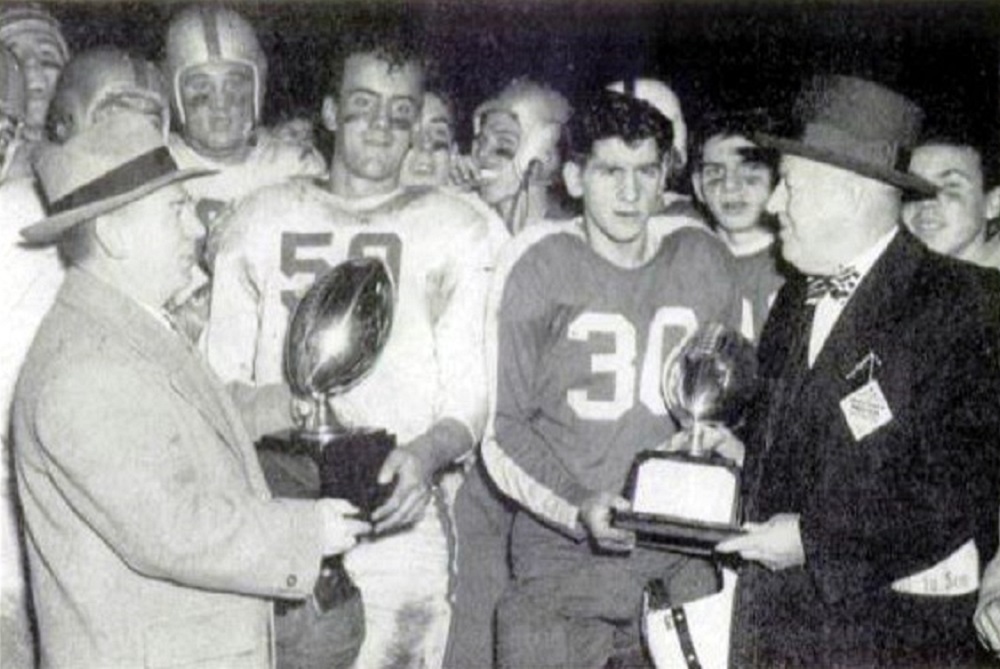
Detroit's Goodfellows Game Pioneered Playing for Good Cause
By
Ron Pesch
MHSAA historian
August 31, 2021
Among the many benefits that come from a football game is the ability to use the gathering for the greater good.
Football games for charity are still played. In Michigan, Lowell High School is well known for its annual Pink Arrow game, created in 2008 to raise money and awareness for all types of cancer. Since that time, numerous schools across the state have done the same, bringing consciousness and much needed financial support to a variety of charities.
Beginning near the end of the 1930s, Detroit’s “Goodfellow Game” set the standard for such contests while becoming a classic of the Detroit sports landscape for 30 years.
The cast of characters fortunate enough to feel a connection to the game — students, coaches, and spectators — is impressive. But, with the final game played in 1967, and the passage of time, those with ties to the game are slowly disappearing.
The season-ending battle was built around a simple concept and became a huge fundraiser for the city’s “Goodfellow” organization, or Old Newsboys as they are often identified. Today, the group is perhaps best known for the yearly tradition of volunteers, stationed on city streets and street corners, selling special edition newspapers near the holiday. The Detroit edition of the organization was founded in 1914, and it still works to make sure no child is forgotten at Christmas.
Football and the Goodfellows
The connection between Detroit’s Goodfellows and football harkens back to at least Nov. 18, 1934, when, according to the book, “The Story of the Goodfellows,” written by Ernest P. Lajoie and published in 1938, “the Detroit Lions, a professional football team, staged a benefit game for the Old Newsboys” with the St. Louis Gunners.
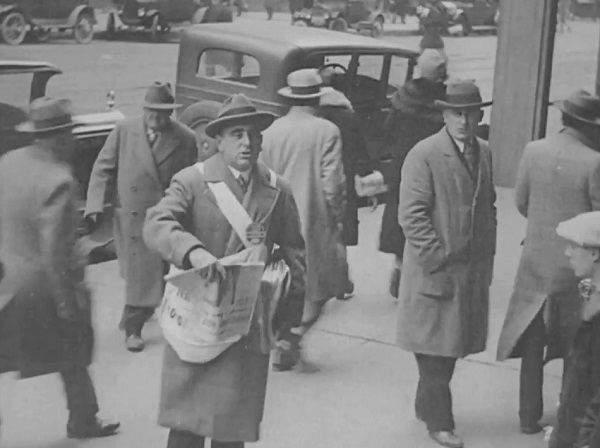 George Albert Richards, radio station owner and the football club’s president, gave the charity the receipts from the game, played before 13,000 at University of Detroit stadium, then tacked on a personal check for an additional $1,000, “as a manifestation of his keen interest in the work of the Old Newsboys.”
George Albert Richards, radio station owner and the football club’s president, gave the charity the receipts from the game, played before 13,000 at University of Detroit stadium, then tacked on a personal check for an additional $1,000, “as a manifestation of his keen interest in the work of the Old Newsboys.”
The Kelly Bowl, played in Chicago and designed to raise money for charity, triggered the idea of mixing the fundraising efforts of the Goodfellow group with high school football. That game, first played in 1934 as well, “pitted the champion of Chicago’s public schools against that of the area’s Catholic League.” According to the Chicago Tribune, this “post-Thanksgiving match between private and public school squads was the only football game that really mattered at the end of the season.” Initially administered under the guidance of Mayor Edward J. Kelly, it was renamed the Prep Bowl during the 1940s.
An estimated crowd of 75,000 packed Soldier Field in 1936, and Detroit attempted to replicate the idea in 1937. Built around the concepts of “bragging rights” and civic pride, the contest would pit the champions of the Detroit Metropolitan League (later known as the City League and/or Public School League) and the Detroit Parochial League (or Catholic League). The winners, of course, could then legitimately call themselves Champions of Detroit.
A committee of the Old Newsboys, headed by Lajoie and two other past presidents of the group, pitched the idea to the officials of both high school leagues. The committee had hoped to arrange a contest between Detroit Catholic Central and Hamtramck high schools, “the only unbeaten or untied elevens in the metropolitan district.” According to the Detroit Free Press, it was estimated that with “favorable weather conditions, more than 15,000 would turn out for the contest.” However, the attempt failed when the committee was unable to get the idea past “Metropolitan League officials because of an iron-clad rule prohibiting post-season contests.”
The potential for good was far too great to drop the idea, so Detroit’s Goodfellow’s organization was back with its pitch in 1938. The Chicago game, according to reports, drew an unimaginable 120,000 football enthusiasts to the 1937 showdown, and this single game generated over $100,000 for the Windy City’s Christmas Fund, designed to help the needy. The colorful press clippings and imagery describing the contest and pageantry from the Chicago media must certainly have been impressive ammunition when arguing the case for trying to duplicate the concept.
In July 1938, Lajoie, representing the group, met with Frank Cody, superintendent of public schools; Rev. Father Carroll F. Deady, superintendent of schools in the Detroit archdiocese; and various other conferees, and he managed to successfully bring the parties together in agreement.
Detroit’s Goodfellow Game
The contest would be “staged on the plan adopted in Chicago for the annual classic in Soldier Field” and feature the champions from the two leagues. Thanks to the generosity of Detroit Tigers owner Walter Briggs, the match-up was scheduled for play at Briggs Stadium, home to both the Major League Baseball Tigers and the National Football League Lions.
“Our aim is to make the meeting an annual one, on the same basis as the Chicago game,” said Lajoie. “(T)he title game is certain to become a sporting fixture in Detroit and one of the classics of the year.”
Scheduling conflicts within the two leagues in that first year meant the contest would have to be played after the normal end of the prep season. Because the Michigan High School Athletic Association regulation barred teams engaging in a game after Thanksgiving Day, special permission was needed to play. A waiver was granted, and on Saturday, Nov. 26, an announced crowd of 30,000—the most ever to watch a prep game in Michigan—gathered at Briggs Stadium for the showdown between heavily favored Hamtramck and Detroit Catholic Central. Special jerseys were ordered to add vivacity to the event.
The Cosmos “will wear blue sweaters with gold numerals, instead of (their normal) maroon with white numbers and (Catholic) Central players will sport gold jerseys with blue letters instead of blue with white,” noted the Detroit Times.
Both teams were again undefeated, with Catholic Central carrying a 25-game win streak into the game, while Hamtramck “a 3-1 favorite before the opening kickoff” carried an 18-game win streak into the contest. Players and fans were greeted by “falling snow and penetrating cold,” but the action on the field quickly cast the weather conditions aside.
The 19-13 victory by Detroit Catholic was, according to John Sabo of the Free Press, “the most spectacular and certainly the most interesting high school football game in Detroit history.
“Outplayed from the start from scrimmage, Catholic Central turned two intercepted passes and an end sweep into three long touchdown gallops which left the powerful Hamtramck team stunned almost before the game was underway.”
“All of Catholic Central’s scoring came in the first half,” noted Bob Murphy of the Times. “John McHale, Catholic Central’s center, supplied the first touchdown on a 52-yard gallop with an intercepted pass early in the game.”
The Cosmos blocked the extra point attempt then responded with their own 54-yard touchdown drive. With a successful point-after attempt, Hamtramck held a 7-6 lead.
Hamtramck had driven to the Shamrocks’ 11-yard line in the second quarter, before the game’s second pass attempt was snatched by 142-pound Rudy DeFrank, the “smallest back in the game,” who “streaked 97 yards down the sidelines to score.”
“The piece-de-resistance,” said Murphy, “was supplied by the swivel-hipped Tony Groth who cut through the heart of Hamtramck’s famed defense for 85 yards and a touchdown.” The score came in the last two minutes of the first half. The Shamrocks “only made one first down in the first half when it was running up its 19 points,” added the Free Press. With the win, Detroit Catholic made a claim to the state’s mythical state championship.
This inaugural battle for city bragging rights netted $22,000 for the Yuletide fund. The span between 1938 and 1967 was filled with thrillers (and a few blowouts) as the annual game generated “some $1.4 million (well in excess of $11 million in 2021 dollars) for the needy at Christmas time” during its run. The chase for the chance to play before a super-sized audience includes a roster of some of the greatest coaches and athletes in metro Detroit athletic prep history.
Goodfellows Game Grows
The 1939 interleague rivalry game, initially planned for Thanksgiving Day, was also a challenge to schedule and was one of two games in the series that were ultimately played in December. The newspapers in the days leading up to the contest between University of Detroit High and Detroit Catholic Central were filled with side stories, helping to build the pomp and circumstance that surrounded the affair. Tickets for the game were available for purchase at local bank branches, pharmacies, and retailers in a variety of locations, including establishments in Motor City architectural gems like the Penobscot Building and the General Motors Building (today known as Cadillac Place).
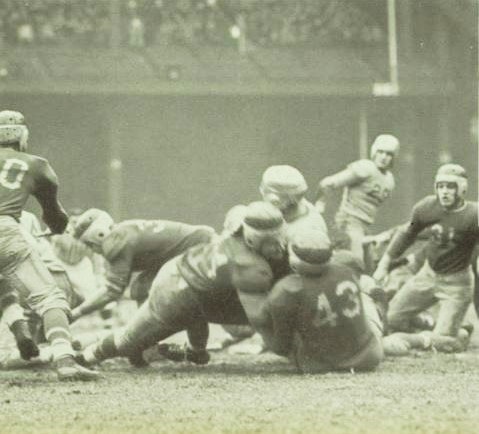 Biographies on the head coaches appeared in print. Hamtramck’s 114-piece band took on the halftime duties for U of D High, as the school did not have a marching band. Both U of D and DCC were all-boys schools. While Catholic Central High for Girls, a separate institution, aligned and cheered for the Shamrocks, there was no such association for U of D. According to the Times, female students from Detroit Cooley chose to adopt the team and cheer it on.
Biographies on the head coaches appeared in print. Hamtramck’s 114-piece band took on the halftime duties for U of D High, as the school did not have a marching band. Both U of D and DCC were all-boys schools. While Catholic Central High for Girls, a separate institution, aligned and cheered for the Shamrocks, there was no such association for U of D. According to the Times, female students from Detroit Cooley chose to adopt the team and cheer it on.
The University of Detroit High Cubs scored a 20-0 win over Detroit Catholic before 23,120 spectators. The victory ended the Shamrocks’ 34-game win streak that dated back to 1934.
Installation of a new drainage system at Briggs had prompted the need for a different location for the 1940 game. Detroit Cooley and Detroit St. Theresa finished in a 6-6 deadlock before a crowd of 14,861, in one of three Goodfellow games that was played at University of Detroit stadium, located at McNichols and Livernois at the northeast corner of the college campus. It marked the first of three ties contained within the results of the 30 contests.
Detroit’s Lions first played on Thanksgiving Day in 1934. However, with the NFL decision to avoid Thanksgiving Day contests between 1939 and 1944 due to World War II, and the MHSAA’s requirement that the football season end no later than that holiday, Goodfellow organizers took advantage of the opportunity. The 1941 game was moved back to Briggs with a scheduled 11 a.m. kickoff. The early start was selected so as to not interfere with traditional celebration dinners. Fire stations were added to the list of locations where tickets could be purchased.
The move was a roaring success, as a new record crowd of 30,714 fans showed up for a repeat of the 1940 match-up. The rematch was tight for the first half, with Cooley grabbing a 14-6 lead over St. Theresa at the break before the Cardinals blew it open, winning 47-6.
“The seven-touchdown parade that Cooley staged could not be considered an upset, and the score and the game’s statistics give a fairly accurate comparison of these two teams, both the tops in their own class, but definitely not in the same class,” said Marshall Dann in the Free Press.
Detroit Catholic Central won back-to-back titles in 1942 and 1943. The ’42 contest, the second, and last, played on Thanksgiving, was a 46-0 mismatch with Hamtramck. The ’43 game, moved back to U of D Stadium due to a pre-scheduled reconditioning at Briggs Stadium, was an 8-0 surprise victory upset over Cooley. Two long spiraling kicks by DCC’s Ed Burgess pinned Cooley deep inside its 10-yard line, leading to Shamrock scores. In comparison to previous years, the reduced crowd of 17,500 spectators was a disappointment.
In the week prior to the game, LaJoie had noted that tickets sales were moving slowly. Underscoring this area of concern was the fact that the Kelly Bowl game in Chicago, played on the same day, attracted 80,000 fans. Detroit News sports editor H.G. Salsinger expressed his opinion that proper promotion of the game by organizers in Detroit was at fault. Other sportswriters concurred.
“What is needed, noted the Free Press, is a group of workers of the type of the New Orleans Sugar Bowl Committee, who will devote time and energy to putting across not only the sale of tickets but the staging of the game as a civic proposition.”
Locally, citizens responded, and for the 1944 match-up, refocused efforts were made to ensure success of the game’s amazing ability to raise significant funds earmarked for the greater good. The Detroit Police Department took over the sale of tickets, improving distribution. Tickets could still be purchased at various locations throughout the city, but now, under the direction of Senior Inspector Samuel J. Throop, they could also be bought directly from any police officer.
The game that fall was moved back to Briggs and dedicated to the memories of four former Goodfellow Game stars, each who had given their lives while serving in World War II. In a battle of previously unbeaten squads, a 13-yard field goal in the last 18 seconds of play by Jerry Wood gave Detroit Mackenzie High a nail-biting 3-0 victory over Holy Redeemer before a throng of 30,054 onlookers.
“Although beaten, Redeemer staged one of the most courageous battles ever witnessed in Briggs Stadium. Four times the Lions halted the Stag’s offensives inside their 15-yard line,” noted the Free Press. It was Wood’s first field goal attempt on the season, although his accuracy on extra points earlier in the year had ensured two other Mackenzie wins.
The public schools won three in a row between 1946 and 1948, including two consecutive by Detroit Denby. A record crowd of 39,004 was on hand for the 1948 game at Briggs, the first played at night on a Friday, when Denby trounced St. Mary’s of Redford, 28-0.
U of D fumbles set up an upset 19-13 victory by East Side underdog St. Anthony in 1949 before 34,038.
Power Begins to Swing
During the 10-game span of the ’50s, the right to brag was equally divided.
In 1950, Detroit Redford squeezed out a 7-6 public school win over little Detroit St. Gregory. The single point win would stand as the thinnest margin of victory in the three-decade run of games.
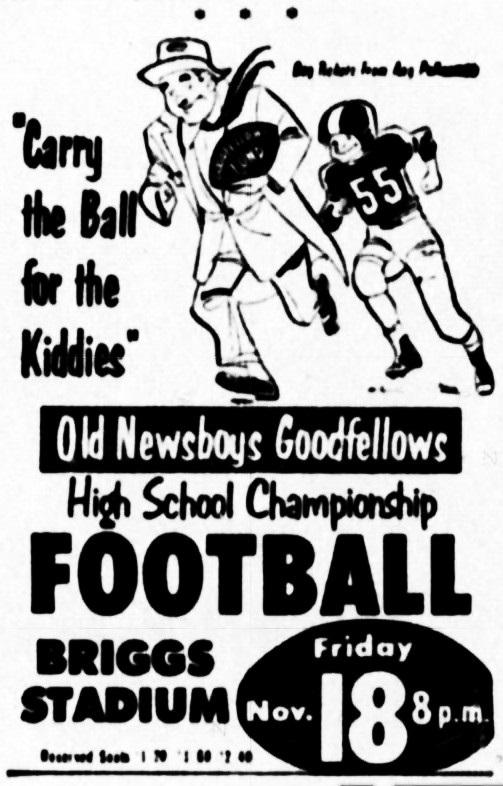 “I’m sure that at the end most of the fans wished there was no such thing as the extra point in football,” wrote Murphy, now sports editor of the Times. “St. Gregory deserved a tie.”
“I’m sure that at the end most of the fans wished there was no such thing as the extra point in football,” wrote Murphy, now sports editor of the Times. “St. Gregory deserved a tie.”
A few days later, a true list of Detroit sports legends attended the annual football bust designed to honor members of both teams.
“The Big Guys paid the Little Guys a visit Tuesday night,” said Hal Schram of the Free Press. “Never before in the 13-year history of the event have so many guest stars attended. “Doak Walker, Leon Hart, Thurman McGraw, Jack Adams, Red Kelly, Gordie Howe, Ted Lindsay, Ted Gray, Harry Heilmann and Bo McMillin all took a bow while several offered brief congratulations.”
Van Patrick, sports director for radio station WJR and play-by-play man for the Tigers and Lions, served as toastmaster.
The St. Mary’s Rustics of Redford, coached by Al Chesney, won consecutive games in ’51 and ’52, then the public schools won three straight between 1953 and 1955.
“The slashing runs of halfback Fred Julian, Pershing High’s finest back since the days of Harry Szulborski (Purdue), enabled the Doughboys to claim their second City football championship in three years,” Schram told his readers in 1955. “Julian scored one touchdown — a brilliant 57-yard spring — and set up the other as Pershing conquered St. Mary of Redford, 13-7 before 29,830 fans in Briggs Stadium Friday night.”
(Julian would later play at the University of Michigan, then for a year in the American Football League for the New York Titans. As head football coach at Grand Rapids West Catholic for 16 years, he guided his team to the MHSAA Class B runner-up finish in 1979.)
Closer Look
Further examination shows that between 1946 and 1955, the City League won seven of 10 games. But as the parochial schools began to draw in more students from across the metro area, fortunes started to shift. The arrival of the 1956 season saw Detroit DeLaSalle down Denby, 26-20. The next 12 years illustrated the growing strength of the Detroit Catholic League in metro Detroit as parochial squads won eight of those showdowns, against three for the city league teams. One game, the 1965 match between Harper Woods Notre Dame and Denby, ended in a 14-14 deadlock.
Coach Dan Boisture of St. Mary of Redford and his younger brother, Tom, coach at little Grosse Pointe St. Ambrose, showcased their coaching chops in the Catholic League and before huge audiences in the Goodfellows Game. (Dan would later assist head coach Duffy Daugherty at Michigan State, then guide Eastern Michigan University’s gridiron squad for seven seasons. Tom would coach at Holy Cross before moving on to the NFL, first as a scout for the New England Patriots, then as director of player personnel for the New York Giants.)
Dan guided St. Mary of Redford to four of five Goodfellow Games, between 1954 and 1958, defeating Southeastern in 1957. Tom led St. Ambrose to, arguably, the greatest upset in the series in 1959, when his team took down top-ranked Cooley behind the running of Joe D’Angelo.
Tied 7-7 with less than 90 seconds remaining, the 5-foot-6, 150-pound “streak of lightening” took a fourth down handoff and “ducked into a “cluster of humanity,” wrote Rick Gosselin in his 2009 book, Goodfellows: The Champions of St. Ambrose.
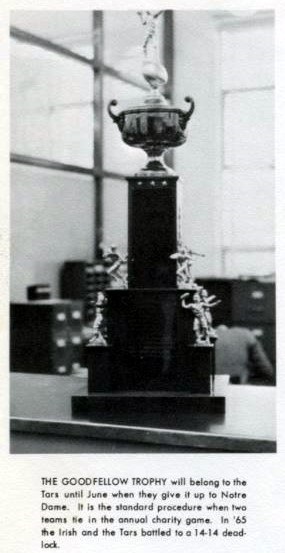 Seemingly stopped at the line of scrimmage by three Cooley linemen — or was it four — D’Angelo kept his feet moving and “squirted loose.” In the play of the game, his 22-yard run gave the Cavaliers a stunning 13-7 lead.
Seemingly stopped at the line of scrimmage by three Cooley linemen — or was it four — D’Angelo kept his feet moving and “squirted loose.” In the play of the game, his 22-yard run gave the Cavaliers a stunning 13-7 lead.
“Cooley would get the ball back with 1:20 remaining,” Gosselin continued. “But like St. Ambrose, the Cardinals were built to win games by running the football, not throwing it. … The biggest upset in Goodfellow history was sealed.”
(D’Angelo would later coach teams at St. Ambrose and Erie Mason, win two MHSAA football titles at Detroit Country Day, then finished his career at Birmingham Hills Cranbrook Kingswood. He retired with 239 victories.)
Gosselin, who graduated from St. Ambrose and Michigan State University and has covered the NFL for 49 years for some of the nation’s largest media outlets, recaps the story of the school without a home field succinctly in Chapter 1 of his publication:
“Over a nine-year period from 1959 through 1967, the Cavaliers would post a 64-8-3 record, winning six conference titles, five Catholic League titles with a perfect 5-0 record in Goodfellow Games, and four state championships. Little St Ambrose would enjoy four 9-0 seasons during that stretch with two other seasons ending with a single loss.”
The 1960 battle at Briggs, a 21-18 come-from-behind victory by Denby over Catholic Central, featured an all-time Goodfellow attendance record of 39,196.
St. Ambrose won consecutive titles in 1961 and 1962 with a pair of shutout victories. Tom Boisture’s ’61 team downed Pershing, 20-0. Boisture’s replacement as coach for the 1962 season was George Perles, who had played in the 1951 game for Detroit Western and would later guide Michigan State’s football squad. Perles guided the team to triumph, 19-0 over Cooley. Each game hosted at the ballpark located at Michigan and Trumbull — by then named Tiger Stadium — drew over 37,000. The 1962 game marked the sixth in a row in which attendance exceeded 30,000.
TV & Tragedy
In 1963, a pair of teams with 6-1 records squared off in the Soup Bowl — the nickname for the Catholic League championship game — for their first-ever chance to play in the Goodfellow Game. Harper Woods Notre Dame and Royal Oak Shrine battled for 48 minutes to a scoreless tie before 17,500 fans at U of D. To determine a winner, league rules awarded the game to the team with the greatest yardage gained. Over the game’s final minute and 26 seconds, Notre Dame had picked up 21 yards during the final series of downs and finished with 163 yards to Shrine’s 159. Hence the Irish scored a “four-yard victory” over the Knights.
One week later, Denby dumped Cooley, the No. 1-ranked team in the state according to the Free Press, 26-13, in the 1963 public school championship game played before another crowd of 17,500 at U of D to earn its third trip to the Goodfellow Game in eight years.
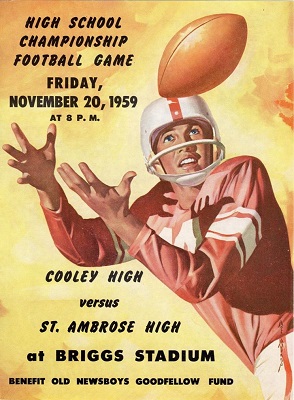 This time, plans were made for a television broadcast of the City Championship game. Game chairman I.A. Capizzi said he didn’t know what effect televising the game might have on gross receipts, but he thought the experiment made sense. WWJ-Channel 4 in Detroit was cancelling the airing of the Bob Hope show and planned to air a 30-minute pregame show, which would “carry the (Goodfellow’s) message of charity work to thousands of viewers.” The hope was that loss in attendance at the gate would be minimal, and that the group might see an increase in revenue during the annual Goodfellow newspaper sales on the streets of Detroit.
This time, plans were made for a television broadcast of the City Championship game. Game chairman I.A. Capizzi said he didn’t know what effect televising the game might have on gross receipts, but he thought the experiment made sense. WWJ-Channel 4 in Detroit was cancelling the airing of the Bob Hope show and planned to air a 30-minute pregame show, which would “carry the (Goodfellow’s) message of charity work to thousands of viewers.” The hope was that loss in attendance at the gate would be minimal, and that the group might see an increase in revenue during the annual Goodfellow newspaper sales on the streets of Detroit.
The transmission would certainly bring the organization’s message before a new audience. Unfortunately, the impact of the test would not be known. Events of the day meant the broadcast would be cancelled.
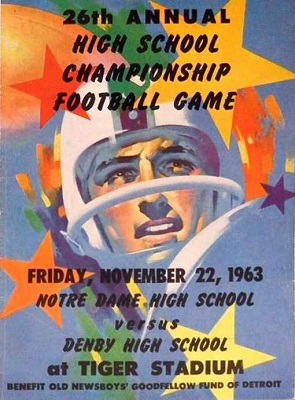 At 1:30 p.m. Michigan time on November 22 — the scheduled day of the 26th Goodfellow Game — President John F. Kennedy was killed while riding in a motorcade in Dallas. Goodfellow officials, faced with an immediate decision, considered rescheduling, but the contest went on as planned, “in spite of the national tragedy.”
At 1:30 p.m. Michigan time on November 22 — the scheduled day of the 26th Goodfellow Game — President John F. Kennedy was killed while riding in a motorcade in Dallas. Goodfellow officials, faced with an immediate decision, considered rescheduling, but the contest went on as planned, “in spite of the national tragedy.”
“The purpose of the game is to provide help for needy children,” Capizzi told the media. “(C)anceling it would have deprived thousands of these children of a visit from Santa. We believe President Kennedy would have concurred in the decision since he held so much love for humanity, especially little children.”
“Both schools also decided it would be unfair to ticket holders to cancel on such notice,” added the Free Press.
To no surprise, attendance suffered with a crowd of 23,500 reported.
Denby won the game, 7-0, beneath a cloud of sorrow as a light rain fell. The win was the Tars’ ninth on the year and 36th in the previous 37 games. With the victory and a No. 1 ranking by the Free Press, they staked a claim on the state’s Class A mythical title.
Attendance Sinks
Fundraising took another hit in 1964. The game, played on a sloppy, slippery Tiger Stadium field, was scheduled for a Thursday night — a school night — as the National Football League restricted use of the field based on the days before a Lions game. Adding to the challenges, a newspaper strike affected publicity for the game. And, this time, the game was televised.
“Only 15,104 fans braved the winter’s first measurable snow (a blizzard) to see St. Ambrose beat Southeastern, 20-0, the smallest crowd ever, the worst weather ever,” reported the Free Press. “(Cavalier Coach) Perles had a nine-inch television monitor at the sidelines. ‘All I could see was snow — on the set and on the field,’ Perles laughed.”
“Television gave us a half hour (before the broadcast) to tell the history of the Goodfellows and their work at Christmas,” noted the group. This time, there was no need for crunching numbers. There was little question that the airing of the game hurt attendance.
Reported gross income of $63,000 from the contest was off significantly from the past averages of $75,000-$80,000. St. Ambrose’s fourth appearance in six years, combined with its fourth victory over City League competition, prompted conversation about adding suburban schools into the mix when determining teams that would meet the parochial champion.
“Extensive grade school, even freshman and reserve programs, give the Catholic League a decided superiority the City League can’t match,” said Dr. Robert Luby, Health and Physical Education Supervisor of the Detroit Public Schools to the Free Press, discussing possible solutions to sagging interest in the game. “(M)aybe it would help to allow suburban schools to take part in the championship."
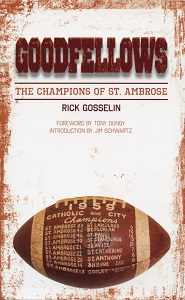 The crowd was back up above 25,000 for the 1965 game, a 14-14 stalemate between Denby and Harper Woods Notre Dame played on a Friday night. Officials looked at playing the 1966 game on a Saturday night at Tiger Stadium, however NFL requirements related to prepping the stadium before a Detroit Lions game again created challenges. When combined with the fact that the Detroit Board of Education had banned night football because of rowdyism and disturbances, the contest was moved back to the University of Detroit and scheduled with a 10:30 a.m. kickoff Saturday, Nov. 19. The early start was designed to avoid competition with the Michigan State-Notre Dame game scheduled for 1:30 p.m.
The crowd was back up above 25,000 for the 1965 game, a 14-14 stalemate between Denby and Harper Woods Notre Dame played on a Friday night. Officials looked at playing the 1966 game on a Saturday night at Tiger Stadium, however NFL requirements related to prepping the stadium before a Detroit Lions game again created challenges. When combined with the fact that the Detroit Board of Education had banned night football because of rowdyism and disturbances, the contest was moved back to the University of Detroit and scheduled with a 10:30 a.m. kickoff Saturday, Nov. 19. The early start was designed to avoid competition with the Michigan State-Notre Dame game scheduled for 1:30 p.m.
“There would be little sense … to try to compete,” said a spokesman. “(Otherwise) we would probably wind up with 20 people.”
As it turned out, only 12,337 fans showed up — less than half the crowd size from the year previous — to watch St. Ambrose win its fifth city championship, 33-19 over Denby. With the triumph, the series was now evenly split, with 13 wins for each league against three tie ballgames.
Reduced costs meant the charity still netted around $45,000, but it was a fraction of past years.
Goodfellow Game’s Clock Hits 0:00
“With Michigan, Michigan State, the Lions, the Red Wings and the Pistons playing away this weekend,” stated the Free Press, “the Denby-Divine Child struggle in the (30th) annual Goodfellow game at Tiger Stadium rates as the top local attraction."
“The game lived up to advance predictions of a knockout,” wrote another newspaper.
Tied 7-7 at the half, a costly fumble gave Dearborn Divine Child a 14-7 upset of Denby. Ed Puishes, the Falcons’ all-state back, scored Divine Child’s first touchdown and would go on to play at the University of Texas at El Paso. Divine Child’s Gary Danielson, a future NFL quarterback, scored the game’s last TD on an eight-yard rollout midway through the third quarter.
Despite the return to the large facility, and a strong matchup, only 15,186 made the trip to Detroit’s Corktown neighborhood. In August 1968, officials announced the end of the annual contest. Sagging interest and attendance figures were mentioned at the forefront, but Free Press coverage also stated that athletic directors from both leagues had “long urged that the game be dropped since it impressed a harsh handicap in scheduling for the entire season.”
Difficulty controlling crowds in recent years was also cited as a concern.
Occasionally, conversations surface about resurrecting the game, but times have changed. With the consolidations and closings of schools within both the Catholic parishes and the Detroit Public School system, the establishment of the MHSAA football postseason, and the influences of Michigan’s school of choice program, it would be nearly impossible to recreate.
Still, the impact of the game on the lives of those who participated in the game, as well as the lives of those who saw Christmas boosted by the work of the Goodfellows, should always be remembered.
The MHSAA is always on the lookout for memorabilia from Michigan’s school sports past. Please contact historian Ron Pesch at the email address below if you have photos, programs, trophies or similar items you’d like to share or donate.
 Ron Pesch has taken an active role in researching the history of MHSAA events since 1985 and began writing for MHSAA Finals programs in 1986, adding additional features and "flashbacks" in 1992. He inherited the title of MHSAA historian from the late Dick Kishpaugh following the 1993-94 school year, and resides in Muskegon. Contact him at [email protected] with ideas for historical articles.
Ron Pesch has taken an active role in researching the history of MHSAA events since 1985 and began writing for MHSAA Finals programs in 1986, adding additional features and "flashbacks" in 1992. He inherited the title of MHSAA historian from the late Dick Kishpaugh following the 1993-94 school year, and resides in Muskegon. Contact him at [email protected] with ideas for historical articles.
PHOTOS: (Top) Members of the Detroit Redford and St. Gregory teams receive their trophies after Redford’s 1950 Goodfellows Game win. (2) The Old Newsboys’ Ernest P. Lajoie sells newspapers on the streets of Detroit. (3) University of Detroit High plays to a 20-0 win over Detroit Catholic Central in 1939. (4) The Detroit Tribune advertises the 1955 Goodfellows game. (5) The 1956 trophy was set to split the year between schools after Denby and Notre Dame tied. (6) The 1959 and 1963 programs reflect the name change at the Goodfellow Games’ home field, Briggs Stadium-turned-Tiger Stadium. (7) Nationally-acclaimed journalist Rick Gosselin tells the Goodfellows story of his alma mater. (Photos gathered by Ron Pesch with courtesy to the Detroit Tribune and local yearbooks.)


